
The Fabaceae or Leguminosae, commonly known as the legume, pea, or bean family, are a large and agriculturally important family of flowering plants. It includes trees, shrubs, and perennial or annual herbaceous plants, which are easily recognized by their fruit (legume) and their compound, stipulate leaves. The family is widely distributed, and is the third-largest land plant family in number of species, behind only the Orchidaceae and Asteraceae, with about 765 genera and nearly 20,000 known species.
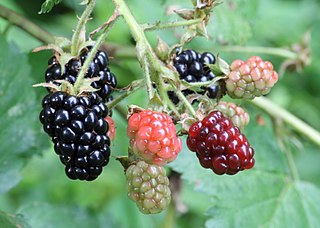
The blackberry is an edible fruit produced by many species in the genus Rubus in the family Rosaceae, hybrids among these species within the subgenus Rubus, and hybrids between the subgenera Rubus and Idaeobatus. The taxonomy of blackberries has historically been confused because of hybridization and apomixis, so that species have often been grouped together and called species aggregates. For example, the entire subgenus Rubus has been called the Rubus fruticosus aggregate, although the species R. fruticosus is considered a synonym of R. plicatus.

The genus Cajanus is a member of the plant family Fabaceae. There are 37 species, mainly distributed across Africa, Asia and Australasia.

Jujube, sometimes jujuba, known by the scientific name Ziziphus jujuba and also called red date, Chinese date, and Chinese jujube, is a species in the genus Ziziphus in the buckthorn family Rhamnaceae.

A legume is a plant in the family Fabaceae, or the fruit or seed of such a plant. When used as a dry grain, the seed is also called a pulse. Legumes are grown agriculturally, primarily for human consumption, for livestock forage and silage, and as soil-enhancing green manure. Well-known legumes include beans, soybeans, chickpeas, peanuts, lentils, lupins, grass peas, mesquite, carob, tamarind, alfalfa, and clover. Legumes produce a botanically unique type of fruit – a simple dry fruit that develops from a simple carpel and usually dehisces on two sides.
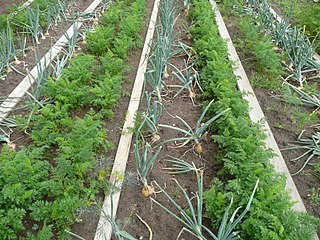
In agriculture, polyculture is the practice of growing more than one crop species in the same space, at the same time. In doing this, polyculture attempts to mimic the diversity of natural ecosystems. Polyculture is the opposite of monoculture, in which only one plant or animal species is cultivated together. Polyculture can improve control of some pests, weeds, and diseases while reducing the need for pesticides. Intercrops of legumes with non-legumes can increase yields on low-nitrogen soils due to biological nitrogen fixation. However, polyculture can reduce crop yields due to competition between the mixed species for light, water, or nutrients. It complicates management as species have different growth rates, days to maturity, and harvest requirements: monoculture is more amenable to mechanisation. For these reasons, many farmers in large-scale agriculture continue to rely on monoculture and use crop rotation to add diversity to the system.

The mountain papaya also known as mountain pawpaw, papayuelo, chamburo, or simply "papaya" is a species of the genus Vasconcellea, native to the Andes of northwestern South America from Colombia south to central Chile, typically growing at altitudes of 1,500–3,000 metres (4,900–9,800 ft).

Spartium junceum, known as Spanish broom, rush broom, or weaver's broom, it is a species of flowering plant in the family Fabaceae and the sole species in the genus Spartium. It is closely related to the other brooms.
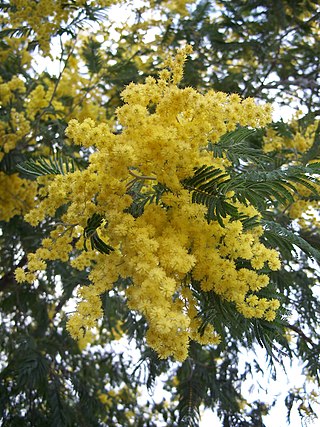
Acacia dealbata, the silver wattle, blue wattle or mimosa, is a species of flowering plant in the legume family Fabaceae, native to southeastern Australia in New South Wales, Victoria, Tasmania, and the Australian Capital Territory, and widely introduced in Mediterranean, warm temperate, and highland tropical landscapes.
Mungbean yellow mosaic virus (MYMV) is a plant pathogenic virus of the family Geminiviridae. Of the various viral diseases inflicting legume crops, Mungbean Yellow Mosaic disease is one of the most destructive and widely distributed. The disease has been reported from various countries.

Cucumeropsis mannii is a species of melon native to tropical Africa west of the East African Rift, where it is grown for food and as a source of oil.
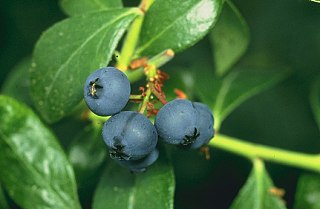
Blueberries are a widely distributed and widespread group of perennial flowering plants with blue or purple berries. They are classified in the section Cyanococcus within the genus Vaccinium. Vaccinium also includes cranberries, bilberries, huckleberries and Madeira blueberries. Commercial blueberries—both wild (lowbush) and cultivated (highbush)—are all native to North America. The highbush varieties were introduced into Europe during the 1930s.
Ancylostomia is a monotypic snout moth genus described by Émile Louis Ragonot in 1893. Its one species, Ancylostomia stercorea, the pigeonpea pod borer, was described by Philipp Christoph Zeller in 1848. It is found in southern Florida, southern Texas, Cuba, Haiti, the Dominican Republic, the Virgin Islands, Jamaica, the Bahamas, Grenada, St. Kitts, Trinidad, Mexico, Guatemala, Costa Rica, Panama, Colombia, French Guiana, Brazil, Guyana, Dominica, Montserrat and Antigua.

Pachyelasma is a genus of flowering plants in the legume subfamily Caesalpinioideae. It contains only one species, Pachyelasmia tessmannii, which is native to central Africa.
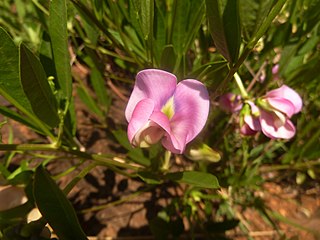
Sphenostylis is a genus of flowering plants in the legume family, Fabaceae. It belongs to the subfamily Faboideae. Sphenostylis contains several species useful as food sources including Sphenostylis stenocarpa.

Alysicarpus vaginalis is a species of flowering plant in the legume family, Fabaceae. It is native to parts of Africa and Asia, and it has been introduced to other continents, such as Australia and the Americas. It is cultivated as a fodder for livestock, for erosion control, and as a green manure. Common names include alyce clover, buffalo clover, buffalo-bur, one-leaf clover, and white moneywort.

Cajanus scarabaeoides is a flowering plant in the genus Cajanus. Of the 32 different species within the genus Cajanus, only one, C. cajan (pigeonpea), is cultivated. Cajanus scarabaeoides is the closest wild relative to C. cajan, and is one of the easiest wild species to cross with pigeonpea cultivars. C. scarabaeoides is found naturally in both temperate and tropical zones around the globe. This species has higher levels of drought tolerance, is found to have greater protein content, and has higher levels of resistance to insect pests compared to cultivated types. These genetic traits can be crossed with C. cajan to improve the crop's productivity. For subsistence farmers, this can reduce economic losses and drastically improve overall crop yield.

Ceratotheca sesamoides is an annual flowering plant in the genus Ceratotheca. It is indigenous to Africa, and grows both as a wild and locally-cultivated species, and is colloquially referred to as false sesame owing to its marked similarities with common sesame. The plant is most commonly cultivated in the African savannah and other semi-arid areas on the continent, and is found across Africa in both tropical and sub-tropical latitudes, usually growing in sandier soils south of the Sahara. It can be identified by numerous hairs on the stem; its pinkish flowers, often showing brown and purple markings; and a sub-erect growth habit. The leaves and flowers are often consumed as a vegetable or used in sauces. The leaves are thought to have medicinal properties, while the seeds can be used to produce cooking oil. Despite its many uses and increasing domestication at a local level, the plant remains predominantly underused and undervalued.

Callosobruchus is a genus of beetles in the family Chrysomelidae, the leaf beetles. It is in the subfamily Bruchinae, the bean weevils. Many beetles in the genus are well known as economically important pests that infest stored foodstuffs.

The pigeon pea is a perennial legume from the family Fabaceae native to the Old World. The pigeon pea is widely cultivated in tropical and semitropical regions around the world, being commonly consumed in South Asia, Southeast Asia, Africa, Latin America and the Caribbean.


















